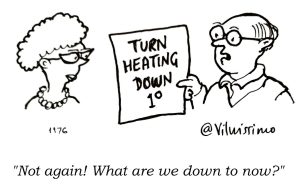This web site doesn’t usually cover domestic energy saving but the topic is of indirect relevance when one is conducting staff energy awareness training. Learning about how to cut energy costs at home is one of the benefits to staff of participating in such programmes.
At the time of writing (October 2022) UK energy prices are increasing dramatically and the media (as ever in such circumstances) are awash with energy-saving tips, many of which are trivial or patronising. As part of any awareness-raising programme it could be useful to steer people away from irrelevant time-wasting ideas and towards things that will actually make a difference. In this article I’ll put some numbers to some of the advice that’s currently doing the rounds. These are rough-and-ready estimates based on a lot of simplifying assumptions and the prices I will use are £0.15 per kWh for gas and £0.52 per kWh for electricity.
Tip no. 1: when cooking, avoid opening the oven door to inspect the contents
The argument presented here is that the hot air will escape and more energy will need to be put in to compensate. Let’s look at that: the capacity of the oven will be of the order of 60 litres. Let’s say all the air in the oven is replaced with room air. 60 litres of room-temperature air will have a mass of 0.07 kg. With a specific heat of near enough 1 kJ.kgK, and supposing a temperature rise of (say) 180 degrees, that implies 0.07 x 1 x 180 = 12.6 kJ = 0.003 kWh, or 0.2 pence wasted. Verdict: bonkers.
To put that in perspective, it’s the equivalent of preheating the oven for 4 seconds longer than needed. But even preheating the oven prematurely isn’t a huge deal. Once up to temperature it will very likely dissipate something of the order of one kilowatt (costing 52p per hour) so ten minutes idle costs only about 9p.
Tip no. 2: don’t boil more water than you need
Suppose you boil 0.5 litre more water than you need. With a specific heat of 4.2 kJ/kgK and assuming cold supply at 10°C, the extra heat supplied is 0.5 x 4.2 x (100-10) = 189 kJ = 0.05 kWh or 2.6 pence worth. Verdict: trivial.
Tip no. 3: use a shower rather than a bath
Let’s look first at the cost of a bath using gas-fired hot water. I’ll assume 100 litre (kg) cold feed at 10°C and bathwater heated to 45°C. At a specific heat of 4.2 kJ/kgK that needs 100 x 4.2 x (45-10) = 14,700 kJ of net heat. Assuming 80% boiler efficiency that equates to 18,375 kJ gross , i.e. 5.1 kWh or say 77 pence.
Contrast that with 10 minutes in an 11kW electric shower: that’s 11 x 10/60 = 1.8 kWh, costing 94 pence, a bit more than the bath. To name a saving you’d need to limit yourself to 8 minutes in the shower. Verdict: marginal
What about a shower fed from the gas heating? Suppose it’s a combi boiler with 16 kW water-heating capacity operating at 80% efficiency (ie 20 kW input) again for ten minutes. That would use 20 x 10/60 = 3.3 kWh of gas, costing 50 pence (27 pence less than the bath). Verdict: unexciting
Tip no. 4: turn off unwanted lights
Let’s take for our example an LED lamp rated at 10 watt. That will cost about 3 pence per hour to run but unlike ovens, kettles and baths, one tends to have a lot of them and use them continually so their cumulative effect in a household could be relatively costly. Eight such lamps run on a daily basis for four hours more than needed would add 8 x 4 x 10 x 365 = 116.8 kWh per year, costing an extra £61 per year. Verdict: do it
